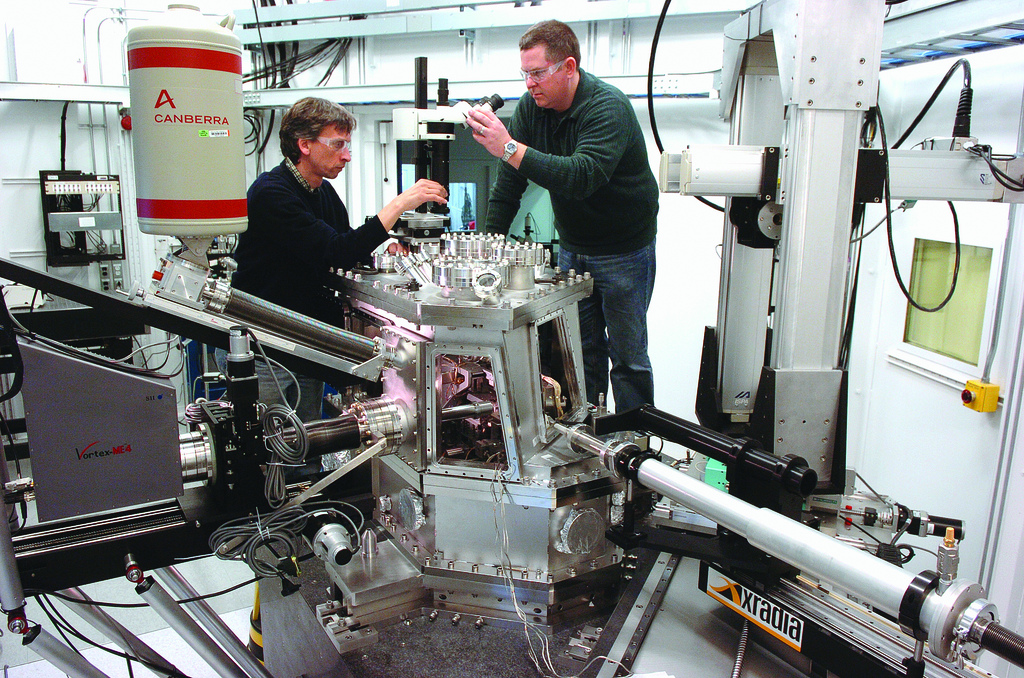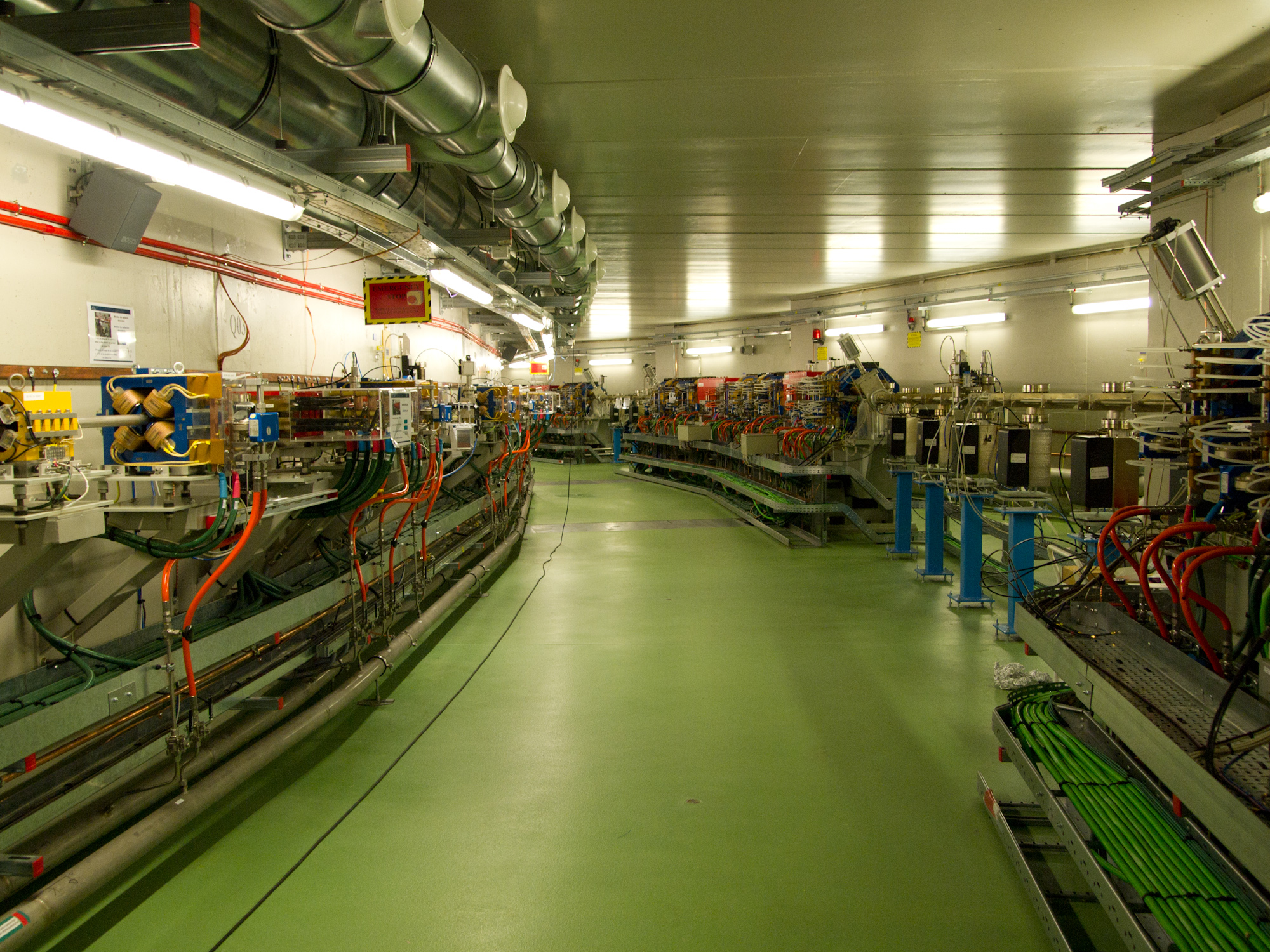|
Diffraction-limited Storage Ring
Diffraction-limited storage rings (DLSR), or ultra-low emittance storage rings, are synchrotron light sources where the emittance of the electron-beam in the storage ring is smaller or comparable to the emittance of the x-ray photon beam they produce at the end of their insertion devices. These facilities operate in the soft to hard x-ray range (100eV—100keV) with extremely high brilliance (in the order of 1021—1022 photons/s/mm2/mrad2/0.1%BW) Together with X-ray free-electron lasers, they constitute the fourth generation of light sources, characterized by a relatively high coherent flux (in the order of 1014—1015photons/s/0.1%BW for DLSR) and enable extended physical and chemical characterizations at the nano-scale. Existing diffraction-limited storage rings *MAX IV Laboratory, in Lund, Sweden. *Sirius, in Campinas, Brazil *European Synchrotron Radiation Facility, Extremely Brilliant SourceESRF-EBS, in Grenoble, France DLSR upgrade or facilities under construction * ... [...More Info...] [...Related Items...] OR: [Wikipedia] [Google] [Baidu] |
Synchrotron Light Source
A synchrotron light source is a source of electromagnetic radiation (EM) usually produced by a storage ring, for scientific and technical purposes. First observed in synchrotrons, synchrotron light is now produced by storage rings and other specialized particle accelerators, typically accelerating electrons. Once the high-energy electron beam has been generated, it is directed into auxiliary components such as bending magnets and insertion devices (undulators or wigglers) in storage rings and free electron lasers. These supply the strong magnetic fields perpendicular to the beam which are needed to convert high energy electrons into photons. The major applications of synchrotron light are in condensed matter physics, materials science, biology and medicine. A large fraction of experiments using synchrotron light involve probing the structure of matter from the sub-nanometer level of electronic structure to the micrometer and millimeter level important in medical imaging. An ... [...More Info...] [...Related Items...] OR: [Wikipedia] [Google] [Baidu] |
Swiss Light Source
The Swiss Light Source (SLS) is a synchrotron located at the Paul Scherrer Institute (PSI) in Switzerland for producing electromagnetic radiation of high brightness. Planning started in 1991, the project was approved in 1997, and first light from the storage ring was seen at December 15, 2000. The experimental program started in June 2001 and it is used for research in materials science, biology and chemistry. Main component of the SLS is the 2.4 GeV electron storage ring of 288 m circumference: The ring is formed by 36 dipole magnets of 1.4 tesla magnetic field, combined in 12 groups of three (triple bend achromat, TBA) for achromatic deflection of the electron beam. 12 straight sections between the TBAs of different lengths (3×11.5 m, 3×7 m, 6×4 m) accommodate the undulator magnets to generate ultraviolet and X-ray light of extreme brightness. 3 of the dipoles have an increased center field of 3 tesla to produce hard X-rays. A total of 177 quadrupole magnets (magnetic lens ... [...More Info...] [...Related Items...] OR: [Wikipedia] [Google] [Baidu] |
X-rays
An X-ray, or, much less commonly, X-radiation, is a penetrating form of high-energy electromagnetic radiation. Most X-rays have a wavelength ranging from 10 Picometre, picometers to 10 Nanometre, nanometers, corresponding to frequency, frequencies in the range 30 Hertz, petahertz to 30 Hertz, exahertz ( to ) and energies in the range 145 electronvolt, eV to 124 keV. X-ray wavelengths are shorter than those of ultraviolet, UV rays and typically longer than those of gamma rays. In many languages, X-radiation is referred to as Röntgen radiation, after the German scientist Wilhelm Röntgen, Wilhelm Conrad Röntgen, who discovered it on November 8, 1895. He named it ''X-radiation'' to signify an unknown type of radiation.Novelline, Robert (1997). ''Squire's Fundamentals of Radiology''. Harvard University Press. 5th edition. . Spellings of ''X-ray(s)'' in English include the variants ''x-ray(s)'', ''xray(s)'', and ''X ray(s)''. The most familiar use of X-ra ... [...More Info...] [...Related Items...] OR: [Wikipedia] [Google] [Baidu] |
Free-electron Laser
A free-electron laser (FEL) is a (fourth generation) light source producing extremely brilliant and short pulses of radiation. An FEL functions and behaves in many ways like a laser, but instead of using stimulated emission from atomic or molecular excitations, it employs relativistic electrons as a gain medium. Radiation is generated by a ''bunch'' of electrons passing through a magnetic structure (called undulator or wiggler). In an FEL, this radiation is further amplified as the radiation re-interacts with the electron bunch such that the electrons start to emit coherently, thus allowing an exponential increase in overall radiation intensity. As electron kinetic energy and undulator parameters can be adapted as desired, free-electron lasers are tunable and can be built for a wider frequency range than any other type of laser, currently ranging in wavelength from microwaves, through terahertz radiation and infrared, to the visible spectrum, ultraviolet, and X-ray. The first ... [...More Info...] [...Related Items...] OR: [Wikipedia] [Google] [Baidu] |
SOLEIL
SOLEIL ("Sun" in French) is a synchrotron facility near Paris, France. It performed its first acceleration of electrons on May 14, 2006. The name ''SOLEIL'' is a backronym for ''Source optimisée de lumière d’énergie intermédiaire du LURE'' (LURE optimised intermediary energy light source), LURE meaning ''Laboratoire pour l'utilisation du rayonnement électromagnétique''. The facility is run by a civil corporation held by the French National Centre for Scientific Research (CNRS) and the French Alternative Energies and Atomic Energy Commission (CEA), two French national research agencies. It is located in Saint-Aubin in the Essonne département, a south-western suburb of Paris, near Gif-sur-Yvette and Saclay, which host other facilities for nuclear and particle physics. The facility is an associate member of the University of Paris-Saclay. SOLEIL also hostIPANEMA, the European research platform on ancient materials (archaeology, palaeontology, past environments and cultu ... [...More Info...] [...Related Items...] OR: [Wikipedia] [Google] [Baidu] |
ALBA (synchrotron)
ALBA (meaning "Sunrise" in Catalan and in Spanish) is a third-generation synchrotron light source facility located in the Barcelona Synchrotron Park in Cerdanyola del Vallès near Barcelona, in Catalonia (Spain). It was constructed and is operated by CELLS (sp: ''Consorcio para la Construcción, Equipamiento y Explotación del Laboratorio de Luz de Sincrotrón'', the Consortium for the Exploitation of the Synchrotron Light Laboratory), and co-financed by the Spanish central administration and regional Catalan Government. After nearly ten years of planning and design work by the Spanish scientific community, the project was approved in 2002 by the Spanish and the regional Catalan governments. After scientific workshops and meetings with prospective users, the facility was redesigned in 2004, and in 2006 construction started. The laboratory was officially opened for experiments on seven beamlines in March 2010. History The project was launched in 1994, the construction began in ... [...More Info...] [...Related Items...] OR: [Wikipedia] [Google] [Baidu] |
High Energy Photon Source
The High Energy Photon Source (HEPS) is a diffraction-limited storage ring synchrotron light source A synchrotron light source is a source of electromagnetic radiation (EM) usually produced by a storage ring, for scientific and technical purposes. First observed in synchrotrons, synchrotron light is now produced by storage rings and other ... producing hard x-ray radiations for scientific applications that will be built in the Huairou District in suburban Beijing, witestimated completion in 2025 See also * Beijing Synchrotron Radiation Facility BSRF in Beijing, China) * Shanghai Synchrotron Radiation FacilitySSRF in Shanghai, China) * National Synchrotron Radiation LaboratoryNSRL in Hefei, China) * Dalian Coherent Light Source (DCLS, VUV FEL in Dalian, China) * Soft X-ray Free Electron Laser (SXFEL,Zhao, 2017 in Shanghai, China) * List of synchrotron radiation facilities Notes {{Reflist References Groundbreaking Ceremony at the High Energy Photon Source in Beijing '' ... [...More Info...] [...Related Items...] OR: [Wikipedia] [Google] [Baidu] |
Diamond Light Source
Diamond Light Source (or Diamond) is the UK's national synchrotron light source science facility located at the Harwell Science and Innovation Campus in Oxfordshire. Its purpose is to produce intense beams of light whose special characteristics are useful in many areas of scientific research. In particular it can be used to investigate the structure and properties of a wide range of materials from proteins (to provide information for designing new and better drugs), and engineering components (such as a fan blade from an aero-engine) to conservation of archeological artifacts (for example Henry VIII's flagship the Mary Rose). There are more than 50 light sources across the world. With an energy of 3 GeV, Diamond is a medium energy synchrotron currently operating with 32 beamlines. Design, construction and finance The Diamond synchrotron is the largest UK-funded scientific facility to be built in the UK since the Nimrod proton synchrotron which was sited at the Rutherfor ... [...More Info...] [...Related Items...] OR: [Wikipedia] [Google] [Baidu] |
Advanced Light Source
The Advanced Light Source (ALS) is a research facility at Lawrence Berkeley National Laboratory in Berkeley, California. One of the world's brightest sources of ultraviolet and soft x-ray light, the ALS is the first "third-generation" synchrotron light source in its energy range, providing multiple extremely bright sources of intense and coherent short-wavelength light for use in scientific experiments by researchers from around the world. It is funded by the US Department of Energy (DOE) and operated by the University of California. In June 2018, Stephen Kevan became the director of the ALS. Users The ALS serves about 2,000 researchers ("users") every year from academic, industrial, and government laboratories worldwide. Experiments at the ALS are performed at nearly 40 beamlines that can operate simultaneously over 5,000 hours per year, resulting in nearly 1,000 scientific publications annually in a wide variety of fields. Any qualified researcher can propose to use an ALS beam ... [...More Info...] [...Related Items...] OR: [Wikipedia] [Google] [Baidu] |
Beam Emittance
In accelerator physics, emittance is a property of a charged particle beam. It refers to the area occupied by the beam in a position-and-momentum phase space. Each particle in a beam can be described by its position and momentum along each of three orthogonal axes, for a total of six position and momentum coordinates. When the position and momentum for a single axis are plotted on a two dimensional graph, the average spread of the coordinates on this plot are the emittance. As such, a beam will have three emittances, one along each axis, which can be described independently. As particle momentum along an axis is usually described as an angle relative to that axis, an area on a position-momentum plot will have dimensions of length × angle (for example, millimeters × milliradian). Emittance is important for analysis of particle beams. As long as the beam is only subjected to conservative forces, Liouville's Theorem shows that emittance is a conserved quantity. If t ... [...More Info...] [...Related Items...] OR: [Wikipedia] [Google] [Baidu] |
PETRA
Petra ( ar, ٱلْبَتْرَاء, Al-Batrāʾ; grc, Πέτρα, "Rock", Nabataean Aramaic, Nabataean: ), originally known to its inhabitants as Raqmu or Raqēmō, is an historic and archaeological city in southern Jordan. It is adjacent to the mountain of Jebel al-Madhbah, Jabal Al-Madbah, in a Depression (geology), basin surrounded by mountains forming the eastern flank of the Arabah valley running from the Dead Sea to the Gulf of Aqaba. The area around Petra has been inhabited from as early as 7000 BC, and the Nabataeans might have settled in what would become the capital city of Nabataean Kingdom, their kingdom as early as the 4th century BC. Archaeological work has only discovered evidence of Nabataean presence dating back to the second century BC, by which time Petra had become their capital. The Nabataeans were nomadic Arabs who invested in Petra's proximity to the incense trade routes by establishing it as a major regional trading hub. The trading business gained ... [...More Info...] [...Related Items...] OR: [Wikipedia] [Google] [Baidu] |






.jpg)